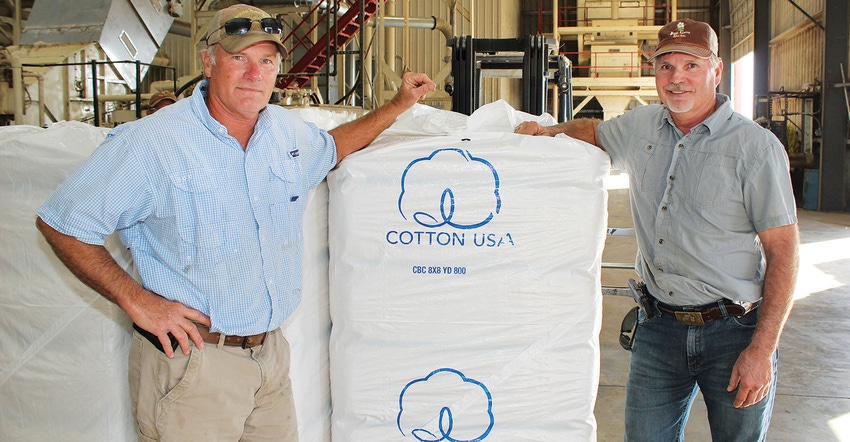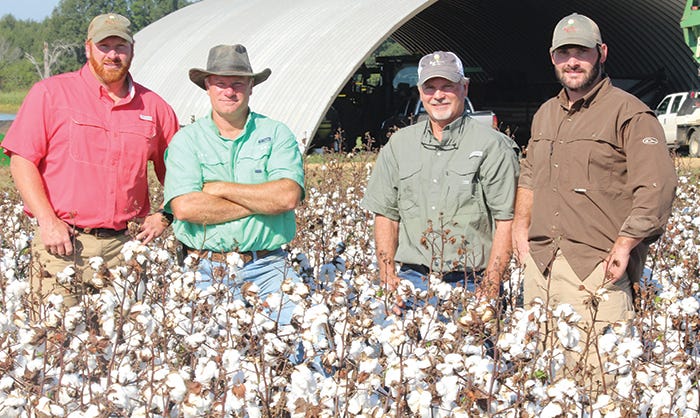
An armada of yellow round modules surrounded Bogue Chitto Gin in late fall 2017, confirming that cotton had come back to Noxubee County, Miss., with a vengeance — thanks in no small part to the recipients of the 2018 High Cotton Award for the Mid-South, brothers Joe and Jack Huerkamp.
This marks the 24th year of the awards, presented by Farm Press and The Cotton Foundation, honoring farmers who combine outstanding production with a concern for the environment.
“The road we’ve traveled to get where we are today has been paved with sweat, sore backs, worry, and a lot of work,” says Jack. “The 1980s were really tough on us. We lost the home and land where we were raised, and never thought we would get it back. But our family stayed strong.”
The brothers agree there were two things that had a direct impact on their return to farming profitability: irrigation and cotton.

In the early 1900s, Noxubee County was the top cotton producing country in Mississippi, and yearly yields now still rank with those in the Delta. “One reason some farmers left this area for the Delta,” says Joe, “is that they had grown cotton year after year, and it just killed their soil fertility levels. And then there were the unrelenting budworms. These days, we rotate corn after cotton because it returns some of those needed nutrients to the soil, and gives us a yield bump.”
Noxubee County’s gummy clay soils are yet another reason many farmers pulled up stakes decades ago and headed west, where they heard the softer Delta soils were easier to work. Today, Joe’s farm is one-fourth corn to three-fourths cotton, with a three-year per acre cotton yield average of 1,559.5 lbs. per acre. Jack’s five-year average is 1,560 pounds, with a one-third corn to two-thirds cotton mix.
WATER/LAND CONSERVATION
Although the brothers farm separately, their production methods are similar. Both understand the importance of irrigation and utilize a combination of methods. Joe even has one 30 acre field with underground drip tape, which is rarely found in their region.
“I’m still not convinced it’s right for us on a large scale,” he says. “Our ground cracks, and the corn attracts rodents that — just to be rodents — chew through the exposed tape. One year, we fixed 56 leaks. Shoveling through 12 inches of clay mud isn’t fun, but I’m not giving up on it because I believe it can reduce our water use and increase our yields.”
Their sons farm as well. Joe’s son, Tyler, probably has the first and only tailwater recovery irrigation system in Noxubee County. He uses gated pipe to flood irrigate, pushing some water uphill — which is impossible with polypipe. He can pump water to a field 10,000 feet away, and relift any runoff going into a nearby creek to reuse until it is gone or until he is through irrigating.
28 CENTER PIVOTS
Retention ponds that catch and accumulate water through the winter dot the Noxubee County countryside. The Huerkamps have several, meticulously monitoring levels through the growing season, and are sticklers about shutting off water flow to any field when it nears the ends of rows. “We push water across quickly,” says Joe, “and then shut it down to conserve water and prevent overwatering.” The brothers have 28 pivots in their irrigation arsenal.
Jack recently began tiling sections of his fields where drainage was poor and limited yield. His yield maps clearly showed where the tile was needed. Joe started tiling field bottoms five years ago, beginning with 30 acres, with more today. Jack is up to 435 acres currently. Brandon tiled one of his fields, and the tiles now pull off so much water he can plant the field four days before untiled fields.
The Huerkamps have found that their cover crops grow faster around the buried tile, particularly after initial installation. After spring burndown, the dead cover crop roots that have grown into the tile vents in places, die and flow out of the tile, causing clogs. That’s the bad. The good is they get a 20 bushel corn yield increase after tiling a field — confirmed by the multi-colored yield map on Jack’s iPhone.
Erosion gullies and lime rock outcroppings were slowing their efforts to work a recently purchased field, so they installed irrigation and changed row direction. This made it a little harder to navigate equipment across the field, but it completely eliminated gully washes.
In 2017, their production ground was 100 percent cover cropped. “Cover crops improve water retention and help prevent erosion, while improving soil health,” says Jack. “They’re worth the hassle of periodically clearing a few clogged tile lines.”
The brothers (and their sons) rotate plots for the Deltapine New Product Evaluator program. It is extra production work, but being part of the NPE program has benefits. “I like seeing varieties are coming down the pipeline,” says Jack, “and more importantly, how they perform on our farms. It’s worth the effort. It helps us cull out varieties early. I just hope it doesn’t change with the Bayer/Monsanto merger.”
EMBRACING TECHNOLOGY
The Huerkamps’ association with Bogue Chitto Gin is another rung of the ladder that led to cotton’s resurgence in Noxubee County. Their zeal for cotton, combined with the unified guidance of the gin’s board of directors, resulted in another great year for the ginning operation.
Not only are they picking their crop with John Deere CP690 on-board module harvesters, they are taking advantage of the RFID tag technology embedded in the yellow wrap to manage the handling of their modules through the gin point. “We’re also looking forward to the information-rich data coming back to us,” says Joe. “We can use the yield and quality data to improve what we do going forward.”
They haven’t utilized that type data in cotton as much as they have in corn — but that is changing thanks to four RFID tags in each wrapped module. “If it deals with precision farming, I’m into it,” Jack says.

Tyler Huerkamp, from left, and his father, Joe, with Jack Huerkamp and his son, Brandon, farm just down the road from Bogue Chitto Gin outside of Macon, Miss.
But he emphasizes that “we don’t adopt technology without fully evaluating how it will benefit our operations. We firmly believe that, in the long-run, technology will assist us in becoming better growers.”
Planting into cover crops presented another hurdle the brothers have learned to manage with new technology. Instead of having to manually move a pin to adjust the spoked wheels of the trash manager during planting, the wheels can now be adjusted from the tractor cab.
“Based on the various levels of residue across the field, I can now adjust the height and the pressure on the trash manager because the wheels are now mounted on air cylinders,” Jack notes. “It really helps to insure proper seed coverage.”
Integrated pest management (IPM) is a way of life for the Huerkamps. To reduce man hours, wear and tear on tires, time on equipment, and soil compaction during the growing season, they rely on the ecosystem-based strategy to help them spray only when necessary, and only where it is needed.
“In 2016, we told ourselves there’s no need to make two trips across our harvested cotton fields to cut and shred stalks,” says Joe. “We can now accomplish it with one trip with a little device we created.
“It sort of freaked John Deere out, but we just can’t buy something and use it only as it was intended — we’ve been told we’re notorious for welding on brand new green paint!”
FROM WHERE THEY CAME
Joe and Jack remember going to the cotton fields with their father, in the days when modules were placed on pallets, and lines of tractors, trailers, and boll buggies caravanned down the rural roads of Noxubee County like linked train cars.
“It was a circus, going field to field with all that equipment,” says Jack. “We struggled back then to increase acreage. The government program held us back. I know many folks didn’t like Freedom to Farm, but I believe Bogue Chitto Gin is in operation today because of it.”
A deep love for cotton has been woven through the fabric of the Huerkamp family for decades. Tyler and Brandon grew up playing in cotton trailers, and are today as dedicated to farming as their fathers.
“The only bad thing about the onboard module harvesters is that youngsters on the farm don’t have trailers in which to play in cotton,” says Joe. Son Tyler immediately chimes in: “That doesn’t hurt my feelings one bit!”
They all erupt in laughter as they turn toward a field of cotton just behind the house where Joe and Jack grew up. It has been repurchased and brought back into the family through hard work, and an unyielding trust in, and love for, cotton — embodying what the Farm Press High Cotton Awards are all about.
About the Author(s)
You May Also Like




